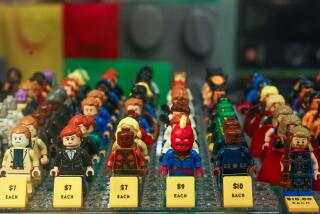Legos, the building blocks of life beyond MIT : Plastic robots do battle on an auditorium table. Students wildly cheer. And recruiters keep watch.
- Share via
BOSTON — “Wastoid! Wastoid! Wastoid!”
That strange cheer rose from a standing-room-only audience inside the Massachusetts Institute of Technology’s Auditorium 26100 as two small robots made of multicolored plastic Legos tangled on a table at the front of the room.
It seems almost comical that some of the nation’s brightest engineering students could become so intensely involved in a game using a common toy. But MIT’s annual 6.270 Lego competition is anything but child’s play.
“The Lego is deceptive,” said Lynn Andrea Stein, assistant professor of computer science at MIT. “These students are really doing something that is state-of-the-art robotics.”
In fact, in the eight years since the 6.270 Lego competition began here, educators have come to see the contest as a remarkable breakthrough in the field of technical education, because it combines all of the elements of a real engineering project.
“This contest offers the students practical, real-world experience in a short amount of time,” said Janet Snyder, a Motorola Inc. engineer who assisted in running this year’s competition. “These Lego robots are the same as any big industrial machine. It has everything they will encounter in industry.”
But perhaps even more important, the 6.270 competition is fun .
Just ask Yishai Lerner of Beverly Hills, Benjamin Caldron of Stockton and Mihir Shah of Dover, Del.--the winners of the 1994 competition, held last week. The trio of 19-year-old engineering students built a robot--nicknamed Wastoid--that not only performed better than 50 other entries but also won by defying the traditional wisdom about the safest way to approach the 6.270 Lego contest, which this year was based on a pirate theme.
Frankly, Wastoid was a showoff.
Unlike the other robots, which approached their assigned tasks in a cautious and deliberate manner, Wastoid boldly crossed into its opponent’s territory, picked up a sponge representing a pirate’s treasure chest and hurled it high into the air--something no other robot had attempted to do in the entire history of the contest.
As a result, Wastoid’s crowd appeal was unmatched.
The audience chanted Wastoid’s name whenever it was time for robot No. 49 to enter another round of combat. And when Wastoid masterfully survived the final skirmish with robot No. 19, the cheers and applause were deafening.
“That was our goal,” Lerner said. “We were sitting up late one night, trying to figure out what to do, and someone asked: ‘What would happen if we threw it?’ It was different. We didn’t think we would win, but we knew everyone would like it.”
Pankaj Oberoi, the principle organizer of the 6.270 competition, said he had warned Lerner, Caldron and Shah that they were making a big mistake by breaking one of the sacred principles of engineering known as KISS: Keep it simple, stupid.
“I told them the first day: ‘You’ve got too many gears. It’ll never work,’ ” Oberoi said.
Surprisingly, even though Wastoid had never successfully tossed the sponge prior to the final competition, it worked flawlessly in the decisive matches.
The 6.270 Lego competition (the number 6.270 is sort of an inside joke among MIT students) was the brainchild of an undergraduate student and continues to be an entirely student-run activity, even though participants get academic credit.
At the beginning of January, each team of contestants receives a box full of Legos, a microprocessor, sensors and other devices needed to build an autonomous robot. Working long hours--often through the night--they produce their entries in little more than three weeks.
The contest’s 130 participants were chosen by lottery from 340 entries. In addition, according to Oberoi, the percentage of robots that actually work has increased every year, reaching 90% this year.
Besides winning a plaque, a $50 gift certificate and the admiration of the MIT students, the victors achieve a lucrative status in the wider world of technology. In fact, Microsoft, one of several corporate sponsors (including Motorola, Polaroid and, of course, Legos) has been known to recruit from the ranks of the 6.270 contestants.
Indeed, students now see the contest as so important to their future that they continue tinkering with their robots until the moment the competition starts. Their hands tremble with excitement and fear as they carefully bring their creations to the tables in the front of the room.
“Half the people lose because they are so nervous they push the wrong button,” Oberoi said.
Even some of the losers are never forgotten. It seems that everyone involved in the 6.270 contest remembers how a 1993 contestant was so overjoyed when his robot finally worked that he shook it hard--and it fell apart.






